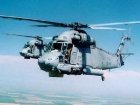'It's Good to Be Diversified'
 Kaman Corporation reported
earnings for Q2_03 at a slim $3.3 million, so very much better than
a net loss of $50.4 million in the same period the previous year.
Net sales for the 2003 second quarter were $216.3 million, compared
to $209.1 million the previous year. For the 2003 six-month period
the company reported net earnings of $17.3 million, compared to a
net loss of $45.0 million the previous year. Six-month net sales
were $432.3 million in 2003, compared to $432.2 million in the 2002
period.
Kaman Corporation reported
earnings for Q2_03 at a slim $3.3 million, so very much better than
a net loss of $50.4 million in the same period the previous year.
Net sales for the 2003 second quarter were $216.3 million, compared
to $209.1 million the previous year. For the 2003 six-month period
the company reported net earnings of $17.3 million, compared to a
net loss of $45.0 million the previous year. Six-month net sales
were $432.3 million in 2003, compared to $432.2 million in the 2002
period.
"We're waiting..."
Paul R. Kuhn, chairman, president and CEO, said, "Results for
the second quarter continued to reflect weakness in key markets
served by the company, including commercial aviation and industrial
production. We were disappointed by the absence of any significant
turnaround in the economy, particularly in the manufacturing
sector; the long-anticipated recovery has not yet materialized, and
the tone of the markets we serve has not turned positive as we
enter the third quarter.
"This has been a good time to be diversified, as Kaman has
traditionally been," Kuhn continued. "Our diversified business base
along with conservative operating practices, low debt levels and
significant available unused credit provide the advantage of
resources and flexibility to weather difficult economic conditions
and take advantage of opportunities to build the company's
businesses, as we have been doing."
 Sales generated by the SH-2G Super
Seasprite (right) and K-MAX helicopter (above and below)
programs, including spare parts and sales support, totaled $18.7
million in the second quarter, which reflects a decrease in SH-2G
sales offset by a small increase in K-MAX spare parts sales,
compared to $13.7 million in the 2002 period, which included a $6.5
million downward adjustment in sales for the Australia SH-2G
program. Helicopter programs represented approximately 30 percent
of segment sales for the quarter, compared to approximately 23
percent a year ago. Except for post-production support, the SH-2G
helicopter program for New Zealand has been successfully completed,
while the Australia program is in its later stages.
Sales generated by the SH-2G Super
Seasprite (right) and K-MAX helicopter (above and below)
programs, including spare parts and sales support, totaled $18.7
million in the second quarter, which reflects a decrease in SH-2G
sales offset by a small increase in K-MAX spare parts sales,
compared to $13.7 million in the 2002 period, which included a $6.5
million downward adjustment in sales for the Australia SH-2G
program. Helicopter programs represented approximately 30 percent
of segment sales for the quarter, compared to approximately 23
percent a year ago. Except for post-production support, the SH-2G
helicopter program for New Zealand has been successfully completed,
while the Australia program is in its later stages.
Helicopter subcontract work involves commercial and military
programs. Current contracts include production of fuselages and
rotor systems for various MD Helicopters, Inc. (MDHI) aircraft.
Total orders received from MDHI have run at significantly lower
rates than originally anticipated. As previously reported, the
company has developed a large investment in these contracts
(including receivables, start-up costs, and other program
expenditures) and has experienced difficulty with receipt of
payments from MDHI. Both during and subsequent to the second
quarter the company received partial payments from MDHI. The
company has recently stopped production on these contracts while it
works with MDHI to resolve payment issues.

Kuhn said, "The Aerospace segment continues to deal with the
combined effects of a lack of helicopter sales, costs associated
with completion of the Australia contract, lower demand for
commercial aircraft, and delayed qualification for the JPF fuze.
While we are working through these issues, we continue to market
our products and capabilities to current and potential customers
here and abroad. We also have taken steps to reduce costs in order
to bring overhead operating rates in line with the revenue base
while positioning the business for future growth. In addition, we
continue to explore possible acquisitions that are accretive in the
short term and advance our goal of expanding the subcontracting
side of this business."
Kuhn concluded, "The company's performance during the second
quarter and first half of 2003 reflects both the absence of
meaningful recovery in the markets Kaman serves, and the process of
working through a series of challenges, particularly in the
Aerospace segment. Actions taken to reduce costs and increase our
presence in strategic markets have helped and are expected to
benefit the company increasingly when economic recovery
occurs."
 ANN's Daily Aero-Linx (04.15.24)
ANN's Daily Aero-Linx (04.15.24) Classic Aero-TV: 'No Other Options' -- The Israeli Air Force's Danny Shapira
Classic Aero-TV: 'No Other Options' -- The Israeli Air Force's Danny Shapira Aero-News: Quote of the Day (04.15.24)
Aero-News: Quote of the Day (04.15.24) Airborne 04.16.24: RV Update, Affordable Flying Expo, Diamond Lil
Airborne 04.16.24: RV Update, Affordable Flying Expo, Diamond Lil ANN's Daily Aero-Term (04.16.24): Chart Supplement US
ANN's Daily Aero-Term (04.16.24): Chart Supplement US




